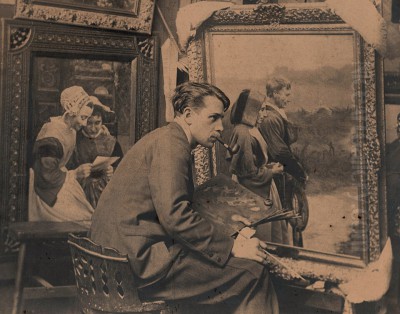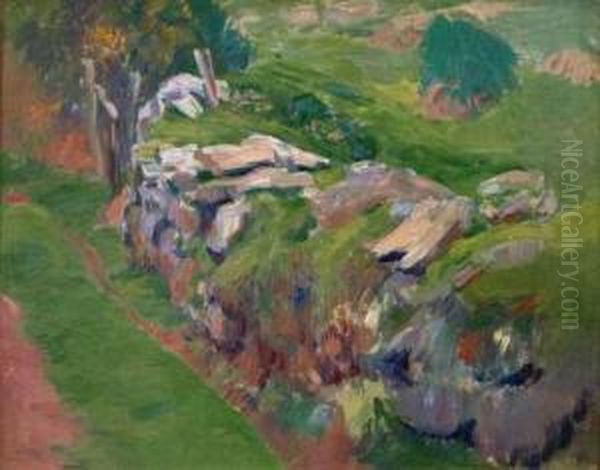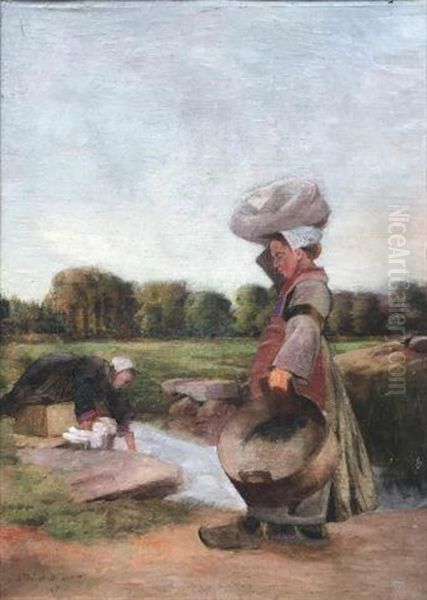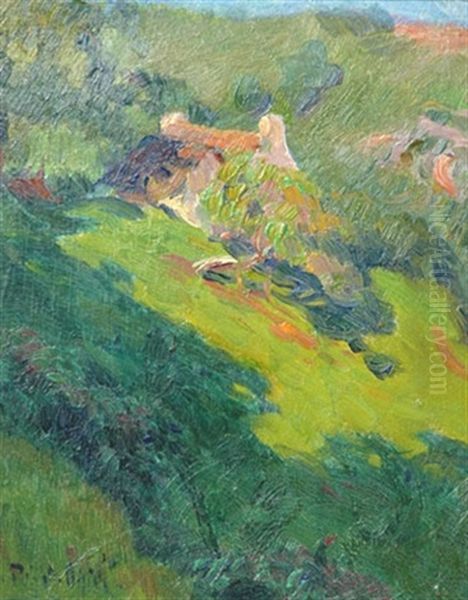
Jean-Bertrand Pegot-Ogier stands as a fascinating, if not widely household, name from a vibrant period in French art. Active during the late 19th and early 20th centuries, his life and work offer a window into the regional artistic expressions that flourished alongside the seismic shifts occurring in the Parisian art epicenter. While perhaps not a revolutionary figure who redefined art history, Pegot-Ogier's dedication to his Breton roots and his engagement with prevailing artistic currents make him a noteworthy artist, whose contributions reflect the rich tapestry of French painting at the turn of the century. His oeuvre, primarily focused on the landscapes and life of Brittany, captures a specific cultural and geographical identity, rendered with a sensitivity that continues to find appreciation.
The Artist and His Epoch
Jean-Bertrand Pegot-Ogier was a French national, born in 1877. His primary period of artistic activity spanned from his formative years until his relatively early death in 1915. This places him squarely within a transformative era for European, and particularly French, art. The world he inhabited as an artist was one of rapid industrialization, social change, and an explosion of new artistic ideas that challenged centuries-old academic traditions. His lifespan coincided with the flourishing of Post-Impressionism, the rise of Symbolism, the decorative elegance of Art Nouveau, and the nascent stirrings of Modernism. Understanding this backdrop is crucial to appreciating the context in which Pegot-Ogier developed his artistic voice.
The Crucible of an Era: Late 19th and Early 20th Century European Art
The period of Pegot-Ogier's activity, roughly 1877 to 1915, was one of the most dynamic and revolutionary in the history of Western art. France, and Paris in particular, was the undisputed center of this artistic ferment. The legacy of Impressionism, which had scandalized the art world in the 1870s with its emphasis on capturing fleeting moments of light and color, was by this time becoming more accepted, paving the way for even more radical departures. Artists like Claude Monet, Auguste Renoir, and Edgar Degas had irrevocably changed the way artists saw and depicted the world.

Following Impressionism, a diverse group of artists, often retrospectively termed Post-Impressionists, pushed painting in highly individual directions. Paul Cézanne sought to "make of Impressionism something solid and durable, like the art of the museums," deconstructing and reconstructing nature into geometric forms. Vincent van Gogh used vibrant, emotionally charged color and expressive brushwork to convey his inner turmoil and spiritual awe. Georges Seurat developed Pointillism, a systematic application of color theory. And, significantly for artists interested in regional cultures and symbolic meaning, Paul Gauguin rejected Western naturalism, seeking more "primitive" and spiritual forms of expression, famously in Brittany and later in Tahiti.
The intellectual and spiritual climate also fostered Symbolism, a movement that turned inward, exploring dreams, myths, and subjective emotional states. Artists such as Gustave Moreau, Odilon Redon, and Pierre Puvis de Chavannes used evocative imagery and suggestive forms rather than direct representation. This interest in the unseen and the symbolic resonated with a broader cultural weariness with materialism and positivism.
Simultaneously, Art Nouveau (or "New Art") swept across Europe, influencing not just painting but also architecture, graphic design, and decorative arts. Characterized by its organic, flowing lines, often inspired by natural forms like plants and flowers, Art Nouveau sought to break down the hierarchy between fine and applied arts. In France, figures like Hector Guimard (famous for his Paris Métro entrances) and in the broader European context, artists like Alphonse Mucha and Gustav Klimt, became leading exponents. This movement also reflected a desire to create a modern style that was not merely imitative of past historical forms.
The industrial revolution had profoundly reshaped society. Urbanization, technological advancements, and new forms of communication and travel created both excitement and anxiety. Some artists embraced modernity, while others, like those associated with the Arts and Crafts movement in Britain or certain aspects of Art Nouveau, reacted against mass production by emphasizing craftsmanship and natural forms. This tension between tradition and modernity, the local and the global, the objective and the subjective, defined the artistic landscape Pegot-Ogier navigated. The influence of non-Western art, particularly Japanese Ukiyo-e prints (which had impacted Impressionists and Post-Impressionists alike) and, increasingly, African and Oceanic art, also began to challenge European artistic conventions.
Jean-Bertrand Pegot-Ogier: A Breton Heart

Within this dynamic European context, Jean-Bertrand Pegot-Ogier carved out his niche, deeply rooted in the culture and landscapes of Brittany. This region in northwestern France, with its distinct Celtic heritage, language, and traditions, had long attracted artists seeking an escape from Parisian modernity and a connection to what they perceived as a more authentic, unspoiled way of life. The Pont-Aven School, famously associated with Paul Gauguin and Émile Bernard in the late 1880s and 1890s, had already established Brittany as a significant site for artistic exploration, emphasizing bold colors, simplified forms, and themes drawn from local peasant life and religious customs.
While Pegot-Ogier was active slightly later and is not formally considered a member of the core Pont-Aven group, his work clearly shows an affinity for its spirit and subject matter. He was reportedly influenced by Gauguin, and his focus on Breton themes—its rugged coastline, its agricultural rhythms, its distinctive costumes, and its enduring Catholic faith—places him within this tradition of regionalist painting. His art suggests a profound affection and intimate understanding of his chosen locale.
Signature Works: A Glimpse into Pegot-Ogier's Canvas
Several works by Jean-Bertrand Pegot-Ogier are known, primarily through auction records and exhibition mentions, offering insights into his thematic concerns and artistic style.
One of his most frequently cited pieces is Femme à la lecture (Woman Reading), an oil painting dated 1903, measuring 16.2 x 24.1 cm. This intimate scene, reportedly dedicated to his girlfriend Suzanne Baudouin, suggests a personal dimension to his work, moving beyond purely landscape or genre scenes. The act of reading itself was a common motif in art of this period, often symbolizing interiority, education, or quiet contemplation.
His dedication to Breton subjects is evident in titles such as Harvest in Brittany. This painting likely depicted the agricultural life of the region, a theme popular among artists who sought to portray the timeless connection between people and the land. Such scenes often carried connotations of rustic simplicity and the dignity of labor, contrasting with the complexities of urban industrial life.
Les lavandières (The Washerwomen) is another work that points to his interest in the daily life of Breton communities. Washerwomen, often depicted at riverbanks, were a recurring subject for artists, allowing for the portrayal of communal activity, the play of light on water, and the picturesque qualities of rural labor.
Petit breton sur le chemin printanier (Little Breton on a Spring Path) evokes the charm of the Breton countryside and its inhabitants, likely featuring a child in traditional Breton attire amidst a landscape awakening in spring. This title suggests a focus on innocence and the beauty of nature, rendered with a sensitivity to seasonal change.

Religious life, a cornerstone of Breton culture, is represented in Pardon à Notre Dame de la Pitié en Guidel. "Pardons" are traditional Breton religious festivals or pilgrimages, often involving processions, special costumes, and communal prayer. These events were visually rich and deeply symbolic, providing fertile ground for artists interested in local customs and spiritual expression.
Finally, Barques sur l'Aven (Boats on the Aven) directly connects Pegot-Ogier to the Aven River, a location central to the Pont-Aven School. This work would have focused on the maritime aspects of Brittany, depicting fishing boats or other vessels on the tranquil waters of the river, a subject that allowed for explorations of light, reflection, and atmosphere.
Stylistic Hallmarks: The Brushstrokes of a Naturalist
Jean-Bertrand Pegot-Ogier's style can generally be characterized as naturalistic, with a clear affinity for capturing the tangible world around him, particularly the landscapes and people of Brittany. His choice of oil and watercolor allowed for different approaches to texture and light. Oil, with its richness and capacity for layering, would have lent itself to more finished, substantial compositions, while watercolor could have been used for quicker sketches, studies of light, or works with a lighter, more translucent feel.
His work demonstrates a keen observational skill, particularly in rendering the specificities of the Breton environment – its unique light, its architectural forms, and the characteristic features of its people. The influence of Paul Gauguin, as noted, might be seen not necessarily in a direct imitation of Gauguin's Synthetist style (with its flat planes of color and strong outlines), but perhaps more in the choice of subject matter, a certain simplification of forms, or an expressive use of color to convey mood and atmosphere.
The connection to the Pont-Aven School, even if informal, suggests an interest in moving beyond purely academic representation towards a more personal and evocative depiction of reality. Artists of this circle were interested in conveying the emotional or spiritual essence of their subjects, not just their superficial appearance. Pegot-Ogier's focus on light and shadow effects, and the creation of layered color, indicates a concern with painterly qualities and the expressive potential of his medium. He aimed to create a sense of place and to communicate his deep appreciation for the Breton world.
Echoes of an Artist: Anecdotes and Personal Touches
Specific, sensational anecdotes about Jean-Bertrand Pegot-Ogier's life are not widely documented in the provided information, which is common for artists who did not achieve the same level of fame as some of their contemporaries. His legacy is primarily constructed through his artworks and their presence in collections and auction markets.
The dedication on Femme à la lecture to "his girlfriend Suzanne Baudouin" offers a rare personal glimpse, humanizing the artist beyond his public artistic persona. It suggests personal relationships that may have informed his work or provided emotional context to his creative endeavors. Such dedications remind us that artworks are often intertwined with the artist's personal life and social connections.
The consistent appearance of his works in auction catalogs, often with his signature, indicates a professional artistic practice and a market for his paintings both during his lifetime and posthumously. This ongoing market presence, however modest compared to art market superstars, signifies a sustained interest in his particular vision of Brittany.
A Constellation of Talent: Contemporaries of Pegot-Ogier
Jean-Bertrand Pegot-Ogier worked during a period teeming with artistic talent. Beyond the towering figures of Post-Impressionism and Symbolism, many other skilled painters were active, contributing to the diverse artistic landscape of France and Europe. Some of these, who were his contemporaries and whose activity overlapped with his (1877-1915), include:
1. Paul Gauguin (1848-1903): A major Post-Impressionist figure, whose work in Brittany and later in the Pacific had a profound impact on modern art and, as noted, on Pegot-Ogier.
2. Émile Bernard (1868-1941): A key collaborator with Gauguin in Pont-Aven and a proponent of Cloisonnism.
3. Henri Matisse (1869-1954): Initially exploring various Post-Impressionist styles before becoming a leader of Fauvism and a dominant figure in 20th-century art.
4. Pierre Bonnard (1867-1947): A founding member of Les Nabis, known for his intimate, color-rich domestic scenes.
5. Edouard Vuillard (1868-1940): Another prominent Nabi artist, celebrated for his depictions of interiors and subtle psychological portraits.
6. Henri de Toulouse-Lautrec (1864-1901): Famous for his portrayals of Parisian nightlife and his innovative poster designs.
7. Victor Schütz (1865-1929): A French painter mentioned as a contemporary, known for landscapes and still lifes. His active period aligns closely with Pegot-Ogier's.
8. Emile Guilleame (1863-1937): Another French painter noted as a contemporary, focusing on rural life and natural landscapes. (The exact spelling and oeuvre of this artist can sometimes be elusive in general records, but he is listed as a contemporary in the source material).
9. Théodore Deyrolle (1845-1924): Active earlier but whose career extended into Pegot-Ogier's period, known for landscapes, still lifes, and significantly, as a scientific illustrator, particularly of natural history.
10. Charles Emile Jeaurat (1861-1934): Listed as a contemporary French painter of landscapes and still lifes. (It's worth noting that Étienne Jeaurat was a more famous 18th-century painter; the prominence of "Charles Emile Jeaurat" from this later period is less established in broader art history, but he is cited as a contemporary).
11. Léon Perousset: An artist whose work Concarres quais les ocangs appeared in the same auction context as Pegot-Ogier's, suggesting a shared market space for Breton or coastal scenes.
12. Edouard Paillart: Another painter whose work, Troupeau de moutons en rives de mer, was featured alongside Pegot-Ogier's, indicating a similar thematic interest in pastoral and coastal subjects.
13. Victor Schnetz (Jean Victor Schnetz, 1787-1870): While his main activity predates Pegot-Ogier significantly, if a later "Victor Schnetz" or if his influence persisted or if works by him were still circulating prominently, he might be considered in a broader historical context. However, the primary Victor Schnetz was a history painter and director of the French Academy in Rome, whose style would be quite different. The mention of his work Etude pour une peinture de paysanne italienne in a similar auction context suggests either a later artist of the same name or a continued market for his studies. Given the dates, it's more likely a different, later Victor Schnetz or a confusion. However, the user's source text lists "Victor SCHNETZ" in a contemporary context.
These artists, ranging from international luminaries to more regionally focused painters, collectively shaped the artistic environment of the time.
Artistic Dialogues: Connections and Comparisons
Direct master-student relationships or close collaborations between Jean-Bertrand Pegot-Ogier and many of the more famous names listed above are not explicitly documented. His primary documented influence is Paul Gauguin, likely absorbed through the general artistic atmosphere and the legacy of Pont-Aven rather than direct tutelage, given Gauguin's departure from Brittany and France.
His relationship with artists like Victor Schütz, Léon Perousset, and Edouard Paillart seems to be one of contemporaries active in similar markets or thematic areas. The appearance of their works in the same auction catalogs suggests they were appealing to a similar collector base, likely interested in traditional French landscape, genre scenes, or specifically Breton subjects. This doesn't necessarily imply direct collaboration or competition in a personal sense, but rather a shared space within the art market of their time.
The lack of confirmed specific master-student relationships with figures like "Victor Schnetz" (assuming the contemporary one from the auction context) or Edouard Paillart, as per the provided information, means their connection was likely one of parallel practice rather than direct artistic lineage in terms of teaching. Pegot-Ogier appears to have developed his style more through regional affinities and the broader artistic currents of his time.
Critical Perspectives: The Evolving Legacy of Pegot-Ogier
The critical reception of Jean-Bertrand Pegot-Ogier seems to have evolved from a relatively modest contemporary presence to a gradual, posthumous recognition, particularly within the market for Breton art. During his lifetime, his exhibition at National Salons would have afforded him a degree of visibility and professional standing, though perhaps not at the vanguard of avant-garde movements.
His connection to the Pont-Aven School, even if informal, and the influence of Gauguin, lend his work a certain art historical significance. However, he is generally not seen as an innovator who radically altered the course of art. Instead, his strength lies in his sincere and skilled depiction of a specific region and its culture, a niche that has its own dedicated admirers.
The continued appearance of his works in auctions, such as Femme à la lecture (estimated at €300-€400 in a past auction, likely early 21st century rather than the future date of Dec 20, 2024, mentioned in the source material, which is probably a typo or placeholder), and other pieces like Petit breton sur le chemin printanier and Pardon à Notre Dame de la Pitié en Guidel, demonstrates an enduring, if specialized, market interest. This suggests that collectors and art lovers continue to value his sensitive portrayals of Brittany.
His artistic evaluation remains somewhat neutral in the grand narratives of art history – he is neither lauded as a forgotten genius nor dismissed as insignificant. Rather, he is appreciated for his competent craftsmanship, his genuine connection to his subject matter, and his contribution to the rich tradition of French regional painting at a time of great artistic change.
On Display: Exhibitions and Public Presence
Jean-Bertrand Pegot-Ogier's work has been featured in various exhibitions and auctions, which contribute to his visibility. A notable recent instance was the exhibition "Thierry Lannon & Associés Present Modern Art," held on December 8, 2018, in Brittany. This event showcased several of his paintings, including La chaumière (The Cottage), Petit breton sur le chemin printanier, and Pardon à Notre Dame de la Pitié en Guidel. Such exhibitions play a vital role in reintroducing regional artists to contemporary audiences and reaffirming their place within art history.
His presence in the auction market is also significant. The aforementioned sale of Femme à la lecture (1903) at the Drouot hotel in Paris is a case in point. Other works, such as Le faucheur (The Reaper, 1900) and Chemin de campagne en Bretagne (Country Road in Brittany), have also appeared in auction catalogs. The circulation of his works like Harvest in Brittany and Barques sur l'Aven through sales and exhibitions further underscores the ongoing appreciation for his art. These events not only establish market value but also provide opportunities for scholarly research and public engagement with his oeuvre.
Conclusion: A Painter of Place and Time
Jean-Bertrand Pegot-Ogier (1877-1915) was an artist deeply connected to his Breton heritage, working during a period of profound artistic transformation in France. While not a central figure in the major avant-garde movements, his work reflects an earnest engagement with the natural beauty, cultural traditions, and daily life of Brittany. Influenced by the legacy of Gauguin and the spirit of the Pont-Aven School, he developed a naturalistic style imbued with a quiet sensitivity.
His paintings, from intimate scenes like Femme à la lecture to depictions of communal life such as Pardon à Notre Dame de la Pitié en Guidel and the pastoral Harvest in Brittany, offer a valuable glimpse into a specific regional identity. Though perhaps overshadowed by more revolutionary contemporaries like Matisse or Picasso, Pegot-Ogier's contribution lies in his authentic portrayal of a beloved landscape and its people. His continued presence in exhibitions and the art market attests to a lasting, if niche, appeal, securing his place as a noteworthy painter of his place and time, a chronicler of the Breton soul on canvas.